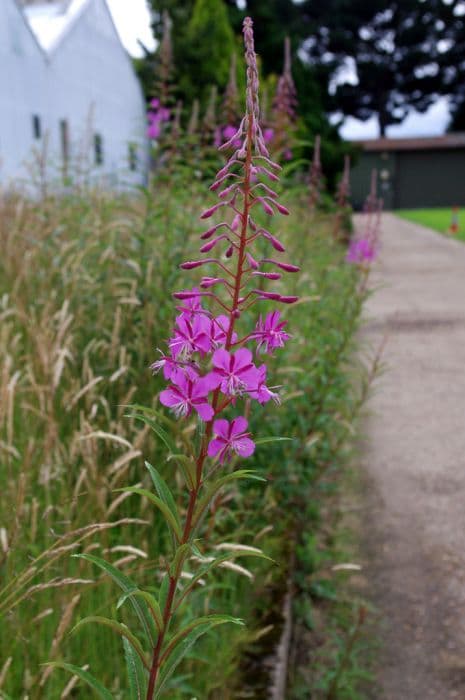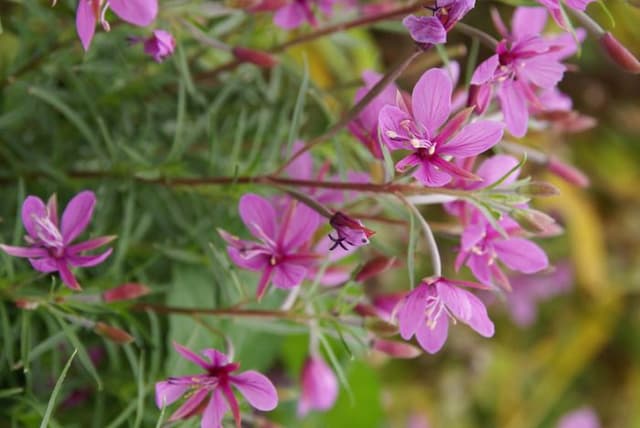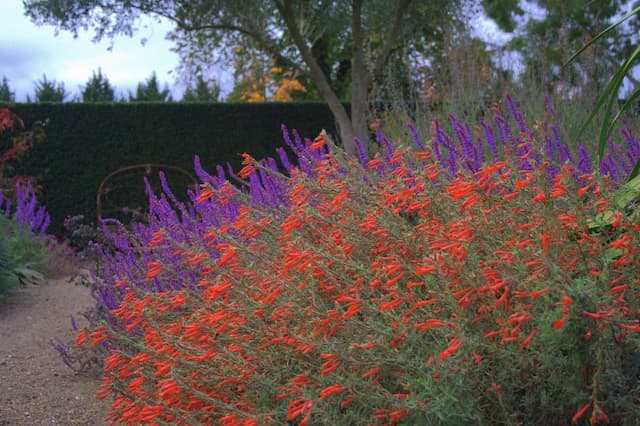Fuchsia Fuchsia 'Mieke Meursing'

ABOUT
The Fuchsia 'Mieke Meursing' is a delightful ornamental plant that showcases a graceful drooping habit with arching branches. It is adorned with striking flowers that dangle elegantly from the stems, drawing the eye with their unique form and vibrant hues. These blossoms typically exhibit an enchanting combination of colors, with the outer petals displaying a deep, rosy pink, while the inner skirts—a vivid purple—emerge from beneath, culminating in a long, slender tube. The sepals, which curve back gracefully from the top of the flowers, further enhance the overall contrast and visual appeal of the blooms. Adding to its ornamental qualities, the foliage of the Fuchsia 'Mieke Meursing' plant presents a lush, deep green color that serves as a perfect backdrop for the vivid flowers. The leaves have a slightly serrated edge, contributing texture and a full-bodied appearance to the plant. Overall, the Fuchsia 'Mieke Meursing' has a cascading demeanor, making it a popular choice for hanging baskets or potted displays, where its floral showmanship can be thoroughly appreciated.
About this plant
 Names
NamesFamily
Onagraceae
Synonyms
Fuchsia, Lady’s Eardrops
Common names
Fuchsia 'Mieke Meursing'.
 Toxicity
ToxicityTo humans
Fuchsia 'Mieke Meursing', most commonly known as Fuchsia, is not generally considered toxic to humans. However, it is always advisable to be cautious and avoid ingesting plants that are not known to be safe for consumption. If ingested in large quantities, there could be potential stomach upset or gastrointestinal discomfort due to the plant's non-edible nature, but Fuchsia does not typically pose a serious poisoning risk to humans.
To pets
Fuchsia 'Mieke Meursing', or simply Fuchsia, is not known to be toxic to pets such as dogs and cats. While it is not recommended for animals to eat ornamental plants due to potential digestive issues, Fuchsia ingestion typically does not result in serious poisoning or toxic symptoms in pets. Nonetheless, pet owners should prevent pets from ingesting the plant as a precautionary measure.
 Characteristics
CharacteristicsLife cycle
Perennials
Foliage type
Deciduous
Color of leaves
Green
Flower color
Mixed
Height
1-2 feet (30-60 cm)
Spread
1-2 feet (30-60 cm)
Plant type
Shrub
Hardiness zones
9
Native area
Central and South America
Benefits
 General Benefits
General Benefits- Ornamental Appeal: Fuchsia 'Mieke Meursing' displays striking two-tone flowers that add visual interest to gardens and outdoor spaces.
- Attracts Pollinators: The vibrant blooms attract hummingbirds and butterflies, supporting local ecosystems.
- Shade Tolerance: It performs well in partial shade, making it an excellent choice for garden spots that don't receive full sun.
- Container Gardening: This plant is suitable for pots and hanging baskets, offering versatility in garden design and space utilization.
- Seasonal Color: It provides a long flowering season, bringing consistent color to the garden from late spring to early fall.
- Easy Pruning: Fuchsia 'Mieke Meursing' can be easily pruned to maintain a desired shape and size, enhancing its ornamental value.
- Versatility: Its aesthetic makes it suitable for a variety of garden styles, including cottage gardens, patio gardens, and more formal bedding arrangements.
 Medical Properties
Medical PropertiesThis plant is not used for medical purposes.
 Air-purifying Qualities
Air-purifying QualitiesThis plant is not specifically known for air purifying qualities.
 Other Uses
Other Uses- Fuchsia 'Mieke Meursing' can be used as a natural dye source, with its bright flowers potentially providing vibrant colors for fabrics or crafts.
- The dropping blooms and foliage of the fuchsia can be included in creative floral art, such as living sculptures or botanical tapestries.
- With proper care, fuchsias can be shaped through pruning into topiaries for ornamental garden accents.
- When positioned strategically, fuchsias can be used as a living privacy screen on balconies or in small gardens.
- The fuchsia can serve as a companion plant to certain vegetables, potentially deterring specific pests with its unique floral scent.
- With its tolerance for shade, the fuchsia can be utilized in themed gardens, such as fairy or woodland gardens, to provide color and interest.
- Fuchsia blossoms can be used to create natural confetti for events like weddings or parties, as they are biodegradable and colorful.
- As part of sensory gardens, the fuchsias' bright colors and textures can be stimulating for both visual and tactile experiences.
- The plants can be incorporated into educational gardens to teach about pollination, as they attract hummingbirds and other pollinators.
- Fuchsia 'Mieke Meursing' can be grown in hanging baskets to create vertical elements in a landscape design, maximizing space and adding aesthetic appeal.
Interesting Facts
 Feng Shui
Feng ShuiThe plant Fuchsia is not used in Feng Shui practice.
 Zodiac Sign Compitability
Zodiac Sign CompitabilityThe plant Fuchsia is not used in astrology practice.
 Plant Symbolism
Plant Symbolism- Confiding Love: Fuchsia flowers are often associated with confiding love. Their hanging blooms can be seen as a symbol of trust and intimacy, reflecting a deep connection between people who share their true feelings with one another.
- Elegance and Good Taste: With their graceful drooping flowers and striking color combinations, fuchsias are commonly linked to elegance and good taste, symbolizing a person's refined appreciation for beauty and sophistication.
- Amiability: The fuchsia's inviting appearance can represent friendliness and warmth. They are a great choice for expressing one’s amiable nature and approachability.
- Overflowing Abundance: Fuchsia plants are often lush and profuse bloomers. The abundance of their flowers can symbolize generosity and a wealth of love, emotions, and ideas ready to be shared.
 Water
WaterFuchsias, including 'Mieke Meursing', need consistent moisture, so water them approximately every 2-3 days, depending on climate conditions and the plant's environment. The method of watering should be to soak the soil around the roots until water begins to drain from the bottom of the container, which might be roughly 16-24 onzes for a standard pot. During hot or windy weather, they might require daily watering, whereas during cooler or rainy periods, the frequency can be reduced. It is pivotal not to let the soil dry out completely, but also not to overwater as this can lead to root rot. Check the top inch of soil for dryness, which if dry, indicates the need for watering.
 Light
LightFuchsias, including 'Mieke Meursing', thrive in bright, indirect light or filtered sunlight. They are best positioned in a spot that offers morning sun and afternoon shade, protecting them from the intense midday sun which can scorch their delicate leaves. An east or north-facing windowsill or a shaded southern or western exposure can be ideal locations for these plants indoors.
 Temperature
TemperatureFuchsia 'Mieke Meursing' prefers cooler temperature conditions and thrives best between 55 and 75 degrees Fahrenheit. They can survive minimum temperatures down to about 40 degrees Fahrenheit but should be protected from freezing temperatures. Maximum temperatures for the fuchsia should not exceed 80 degrees Fahrenheit, as higher temperatures can cause stress and damage to the plant.
 Pruning
PruningPruning fuchsias such as 'Mieke Meursing' is essential to encourage bushy growth and abundant flowering. Prune in the spring before new growth begins, removing dead or weak branches and shaping the plant as desired. Pruning may be done again lightly throughout the growing season to remove faded flowers and seed pods. The best time for the main pruning is early spring, just before the last expected frost date.
 Cleaning
CleaningAs needed
 Soil
SoilThe Fuchsia 'Mieke Meursing' thrives in a well-draining, fertile soil mix with a peat moss base, perlite, and loam. The ideal pH for this fuchsia should be slightly acidic to neutral, ranging from 6.0 to 7.0.
 Repotting
RepottingFuchsia 'Mieke Meursing' should be repotted every 2-3 years or when it becomes root-bound. Repotting in early spring is generally best for the plant's health.
 Humidity & Misting
Humidity & MistingFuchsia 'Mieke Meursing' prefers high humidity levels, ideally between 60% to 70%, which encourages robust growth and flowering.
 Suitable locations
Suitable locationsIndoor
Keep in bright, indirect light and maintain high humidity.
Outdoor
Place in partial shade, shelter from wind, and keep soil moist.
Hardiness zone
9-11 USDA
 Life cycle
Life cycleThe Fuchsia 'Mieke Meursing', commonly known as the hardy fuchsia or lady’s eardrops, begins its life cycle as a seed, typically germinating in warm, moist soil conditions in early spring. Upon germination, it forms a small seedling, which then grows into a mature plant, characterized by its bushy habit and striking, pendulous flowers that can appear from late spring to early fall. Throughout the growing season, the plant actively produces leaves and flowers, engaging in photosynthesis and attracting pollinators. After the flowering period, the plant produces tiny fruit that contains seeds, which can then be dispersed to facilitate the next generation. As temperatures drop in autumn, the fuchsia plant enters a dormancy phase where growth slows and the plant may lose some leaves, hunkering down to survive through cooler winter conditions. With the return of warmer weather, the fuchsia exits dormancy, resuming growth and starting its cycle anew.
 Propogation
PropogationPropogation time
Spring-Early Summer
Fuchsia 'Mieke Meursing', commonly known as Fuchsia, is typically propagated through softwood cuttings, which is the most popular method. The best time to take cuttings for propagation is late spring to early summer when the plant's growth is most active. To propagate by cuttings, select a healthy, non-flowering shoot and cut a 3- to 4-inch (approximately 7.5 to 10 cm) segment just below a leaf node. Remove the lower leaves, and dip the cut end in rooting hormone. Plant the cutting in a moist potting mix, ensuring the node where the leaves were removed is beneath the soil surface. Cover the cutting with a plastic bag or place in a propagator to maintain high humidity, and keep it out of direct sunlight until roots have developed, which usually takes about 3 to 4 weeks. Once rooted, the cuttings can be transplanted into individual pots.









